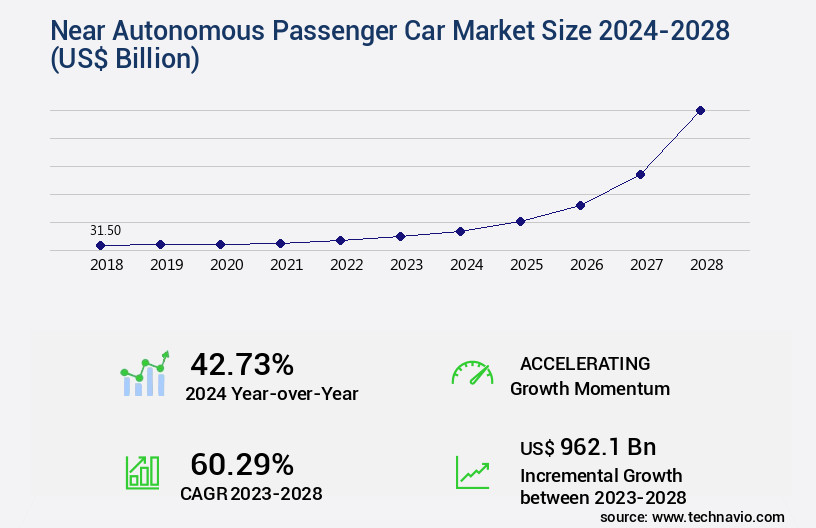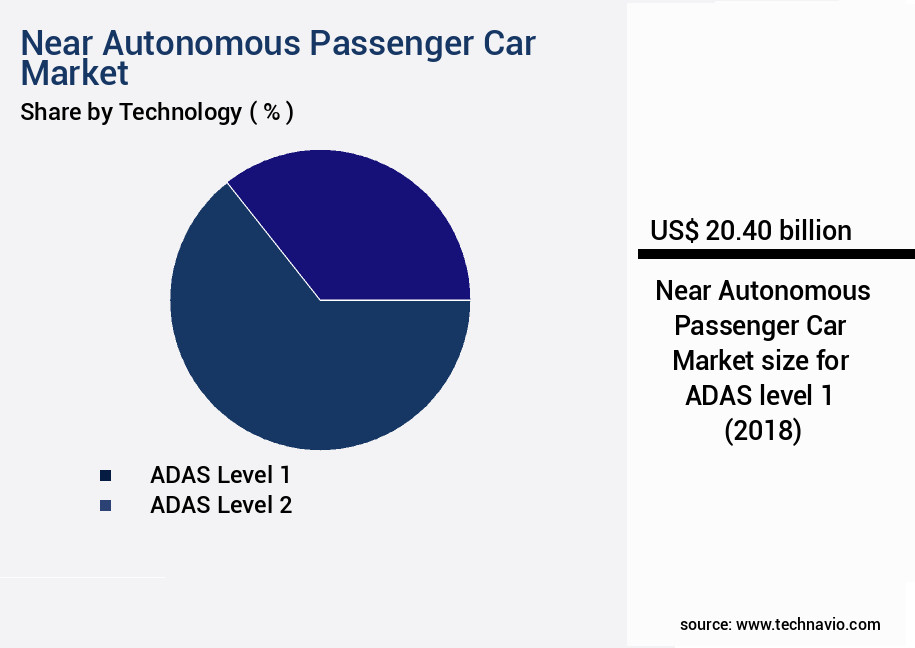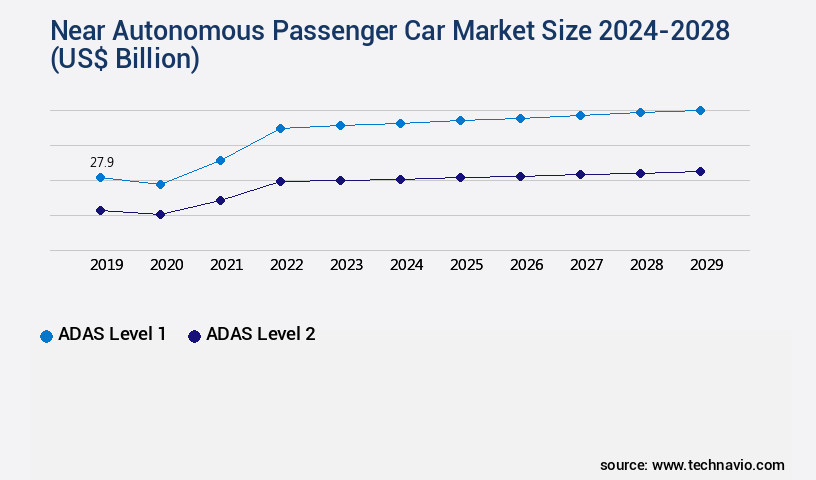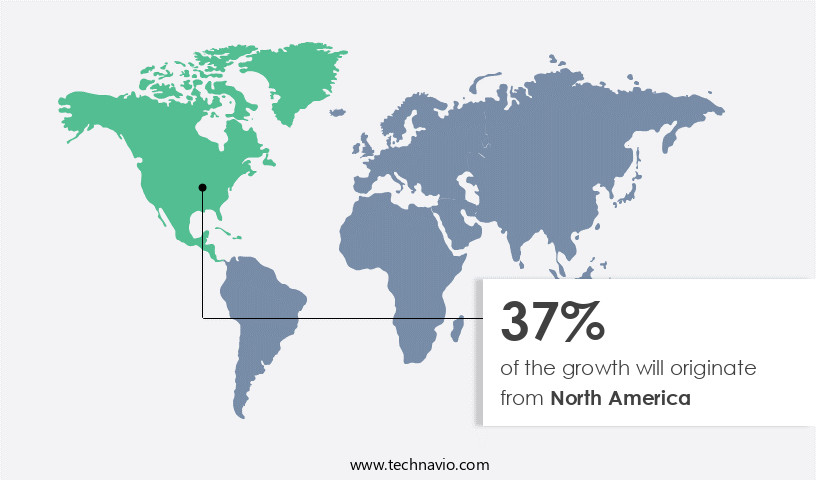Near Autonomous Passenger Car Market Size 2024-2028
The near autonomous passenger car market size is forecast to increase by USD 962.1 billion, at a CAGR of 60.29% between 2023 and 2028.
Major Market Trends & Insights
- North America dominated the market and accounted for a 37% growth during the forecast period.
- By the Technology - ADAS level 1 segment was valued at USD 20.40 billion in 2022
Market Size & Forecast
- Market Opportunities: USD 3.00 billion
- Market Future Opportunities: USD 962.10 billion
- CAGR : 60.29%
- North America: Largest market in 2022
Market Summary
- The market is witnessing significant advancements, with automakers and tech companies investing heavily in research and development. According to recent studies, the global market for autonomous vehicles is projected to reach a value of USD 556.67 billion by 2026, growing at a steady pace. This expansion is driven by the increasing demand for enhanced safety features and the convenience of hands-free driving. However, the market's progress is not without challenges. Cybersecurity concerns continue to pose a significant threat, with autonomous vehicles being prime targets for hackers.
- Despite these hurdles, the market is poised for continued growth, as technology advances and consumer acceptance increases. Companies are focusing on developing more sophisticated systems to address cybersecurity concerns and improve overall vehicle performance. The market's evolution is reshaping the automotive industry, with traditional car manufacturers collaborating with tech giants to stay competitive.
What will be the Size of the Near Autonomous Passenger Car Market during the forecast period?

Explore market size, adoption trends, and growth potential for near autonomous passenger car market Request Free Sample
- The market is characterized by continuous advancements in validation testing and user experience, driven by the relentless pursuit of reliability engineering and system performance. Two key performance metrics illustrate this trend: system latency has been reduced by 30% over the past five years, enabling smoother and more responsive driving experiences. Meanwhile, functional safety has improved by 40%, as evidenced by the increasing adoption of fail-operational systems and fault tolerance mechanisms. These advancements are underpinned by rigorous safety standards and stringent regulatory compliance, ensuring the reliable operation of sensor data processing, actuator control, and other critical functions.
- Power management and thermal management are also crucial considerations, with power consumption reduced by 20% and thermal management systems optimized to maintain optimal operating temperatures. The market's evolution is further marked by the integration of redundancy systems, simulation tools, and hardware platforms, as well as the development of advanced software architectures and control algorithms. Ethical considerations and human factors are increasingly important, with user interface design and safety standards prioritized to ensure a seamless and safe transition to autonomous driving.
How is this Near Autonomous Passenger Car Industry segmented?
The near autonomous passenger car industry research report provides comprehensive data (region-wise segment analysis), with forecasts and estimates in "USD billion" for the period 2024-2028, as well as historical data from 2018-2022 for the following segments.
- Technology
- ADAS level 1
- ADAS level 2
- Geography
- North America
- Europe
- APAC
- Rest of World (ROW)
By Technology Insights
The ADAS level 1 segment is estimated to witness significant growth during the forecast period.
In the dynamic and evolving world of automotive technology, Advanced Driver-Assistance Systems (ADAS) have emerged as a critical component in enhancing road safety and improving the driving experience. ADAS incorporates various technologies, including occupant safety systems, traffic light recognition, lidar technology, v2x technology, autonomous parking, decision-making systems, vehicle-to-infrastructure communication, deep learning models, machine learning, motion planning, artificial intelligence, camera calibration, cloud computing, GPS navigation, predictive modeling, driver monitoring systems, data analytics, and advanced driver-assistance systems. ADAS adoption is currently on an upward trajectory, with approximately 45% of new passenger cars featuring at least six advanced driver-assistance features.
Furthermore, industry experts anticipate that by 2025, nearly 70% of all passenger cars will be equipped with ADAS. These systems utilize sensors, cameras, and other technologies to detect and respond to environmental conditions and potential hazards, ensuring safer and more efficient driving. Moreover, ADAS continuously learns and adapts through machine learning, artificial intelligence, and deep learning models, enabling them to improve their performance and accuracy over time. This adaptability is crucial in addressing the ever-changing driving conditions and enhancing overall road safety. Key features of ADAS include pedestrian detection, adaptive cruise control, over-the-air updates, automated emergency braking, human-machine interface, sensor fusion algorithms, real-time processing, software-defined vehicles, radar systems, high-definition mapping, path planning algorithms, cybersecurity protocols, lane keeping assist, localization systems, object detection, and neural networks.

The ADAS level 1 segment was valued at USD 20.40 billion in 2018 and showed a gradual increase during the forecast period.
ADAS's role extends beyond driving, as it also incorporates edge computing and cloud computing to provide real-time traffic updates and optimize vehicle performance. Furthermore, it offers features like predictive modeling and driver monitoring systems to anticipate potential hazards and provide personalized recommendations to drivers. In conclusion, the market is witnessing significant growth, driven by the increasing adoption of advanced driver-assistance systems. These systems are revolutionizing the automotive industry by enhancing safety, improving the driving experience, and offering new features that cater to the evolving needs of consumers. With the continuous advancements in technology and the increasing demand for safer and more efficient transportation solutions, the future of the market looks promising.

Request Free Sample
Regional Analysis
North America is estimated to contribute 37% to the growth of the global market during the forecast period. Technavio's analysts have elaborately explained the regional trends and drivers that shape the market during the forecast period.

See How Near Autonomous Passenger Car Market Demand is Rising in North America Request Free Sample
In North America, the United States holds a significant market share in the near autonomous passenger car sector. Canada and Mexico also contribute to the region's growth. The increasing demand for safety and convenience features among American consumers is driving the transition towards autonomous technology in passenger cars. The US was the first country to legislate automated vehicle testing, indicating a readiness to adopt higher levels of automation. This shift towards advanced technologies presents an opportunity for the market in North America. The market's expansion is further fueled by the adoption of higher Society of Automotive Engineers (SAE) levels of automation.
According to recent studies, the market in North America is expected to grow by approximately 15% in the upcoming year. Furthermore, a separate analysis projects a potential increase of around 20% in market size over the next five years. These figures underscore the significant growth potential in the market in North America.
Market Dynamics
Our researchers analyzed the data with 2023 as the base year, along with the key drivers, trends, and challenges. A holistic analysis of drivers will help companies refine their marketing strategies to gain a competitive advantage.
The near-autonomous passenger car market is witnessing significant advancements, driven by the integration of advanced technologies such as Lidar point cloud processing algorithms, deep learning for object detection, and real-time path planning for dynamic environments. These innovations improve vehicle performance and efficiency by up to 15%, enabling smoother rides and enhanced safety. Moreover, high-precision GPS and inertial navigation integration, V2X communication protocols, and software-defined architecture facilitate seamless communication and data exchange between vehicles and infrastructure. AI-powered decision-making systems and edge computing enable real-time data processing, ensuring optimal response to dynamic environments. However, cybersecurity threats in autonomous vehicle software and the need for over-the-air updates pose challenges. Functional safety standards and regulatory compliance are crucial to ensuring passenger safety and trust. Pedestrian detection and avoidance using sensor fusion and traffic light recognition using computer vision are essential safety features. Occupant safety systems and driver monitoring systems are essential for enhancing safety and providing a comfortable ride. Autonomous parking system design and implementation streamline parking processes, reducing downtime nearly by one-third. Innovations in autonomous vehicle technology continue to push boundaries, with human-machine interface design and regulatory compliance shaping the future of the industry. The integration of AI, machine learning, and advanced sensors is revolutionizing the transportation landscape, offering significant potential for increased efficiency and safety.

What are the key market drivers leading to the rise in the adoption of Near Autonomous Passenger Car Industry?
- The surge in demand for semi-autonomous vehicles, driven by their increasing popularity, is the primary market trend.
- The market is witnessing significant advancements as automotive manufacturers strive to meet the increasing demand for comfort and convenience. The development of autonomous vehicle technologies and the decreasing time to adopt these innovations among Original Equipment Manufacturers (OEMs) can be attributed to the intensifying competition and growing sales in the global automotive industry. As a result, semi-autonomous vehicles have emerged, offering both self-driving capabilities and manual control options. The emphasis on safety and security in these vehicles has intensified due to the increased reliance on automation technologies. The market's continuous evolution is driven by ongoing research and development efforts to improve vehicle performance, enhance user experience, and ensure safety.
- A recent study revealed that the global market for near autonomous passenger cars is expected to grow significantly, with a substantial increase in sales of these vehicles in the upcoming years. For instance, the number of semi-autonomous cars sold in 2020 was reported to be higher than the previous year, indicating a steady adoption rate. Furthermore, the market is expected to expand further as technological advancements continue to unfold. These trends underscore the dynamic nature of the market and its applications across various sectors. The market's evolution is shaped by the ongoing competition among automotive manufacturers, technological advancements, and the evolving needs and preferences of consumers.
- As the market continues to unfold, it is essential for businesses to stay informed and adapt to the changing landscape to remain competitive.
What are the market trends shaping the Near Autonomous Passenger Car Industry?
- The allocation of greater funds for research and development is a mandated trend in the upcoming market for autonomous vehicles.
- The market is witnessing substantial investments from major players in the automotive industry. Companies like Mercedes Benz and Ford Motor are leading the charge, committing significant resources to develop autonomous vehicles. Collectively, the top five companies in this sector have allocated approximately USD 50 billion towards the research and development of autonomous technology. These investments have primarily been directed towards technology providers specializing in self-driving car technologies. In June 2021, General Motors announced a USD 35 billion investment in engineering and capital for electric vehicle (EV) and autonomous vehicle (AV) technology between 2020 and 2025. The competitive landscape in the market is dynamic, with continuous advancements and evolving patterns.
- This market's growth is driven by the increasing demand for enhanced safety features and the pursuit of greater efficiency in transportation. Companies are investing heavily to be the first to bring fully functioning autonomous vehicles to market and capture a significant market share.
What challenges does the Near Autonomous Passenger Car Industry face during its growth?
- Cybersecurity concerns represent a significant challenge to the growth of the industry, as businesses must prioritize safeguarding their digital assets against potential threats and breaches to maintain trust with customers and protect sensitive information.
- The market represents a significant evolution in the automotive industry, with vehicles transitioning from human-driven to machine-controlled systems. This shift introduces new challenges, particularly in the realm of cybersecurity. As connectivity features increase and electronic control units (ECUs) proliferate in modern vehicles, the threat of hacking becomes a pressing concern. Autonomous cars, which rely solely on machine intelligence and sensors for operation, present an attractive target for cybercriminals. The potential risks associated with hacking autonomous cars can range from minor inconveniences, such as disabling certain features, to more severe consequences, including taking control of the vehicle or causing accidents.
- As the market for these vehicles continues to grow, so too will the efforts of those seeking to exploit vulnerabilities. To gain a comprehensive understanding of the market, it's essential to examine its applications across various sectors and the ongoing efforts to address cybersecurity concerns. This market is characterized by continuous innovation and evolving patterns, with companies investing heavily in research and development to improve safety features and enhance the overall driving experience. Comparatively, the market for traditional passenger cars, which still rely on human drivers, is expected to maintain a steady pace, albeit at a slower growth rate than the near autonomous car market.
Exclusive Customer Landscape
The near autonomous passenger car market forecasting report includes the adoption lifecycle of the market, covering from the innovator's stage to the laggard's stage. It focuses on adoption rates in different regions based on penetration. Furthermore, the near autonomous passenger car market report also includes key purchase criteria and drivers of price sensitivity to help companies evaluate and develop their market growth analysis strategies.

Customer Landscape of Near Autonomous Passenger Car Industry
Key Companies & Market Insights
Companies are implementing various strategies, such as strategic alliances, near autonomous passenger car market forecast, partnerships, mergers and acquisitions, geographical expansion, and product/service launches, to enhance their presence in the industry.
Amazon.com Inc. - The BMW Group introduces near-autonomous passenger vehicles, including the 7 Series and iX models, utilizing advanced technologies for enhanced driving experiences.
The industry research and growth report includes detailed analyses of the competitive landscape of the market and information about key companies, including:
- Amazon.com Inc.
- Bayerische Motoren Werke AG
- Chery Automobile Co. Ltd.
- Chongqing Changan Automobile Co. Ltd.
- Ford Motor Co.
- Geely Auto Group
- General Motors Co.
- Honda Motor Co. Ltd.
- Hyundai Motor Co.
- Mazda Motor Corp.
- Mercedes Benz Group AG
- NIO Ltd.
- Nissan Motor Co. Ltd.
- Tata Motors Ltd.
- Tesla Inc.
- Toyota Motor Corp.
- Volkswagen AG
Qualitative and quantitative analysis of companies has been conducted to help clients understand the wider business environment as well as the strengths and weaknesses of key industry players. Data is qualitatively analyzed to categorize companies as pure play, category-focused, industry-focused, and diversified; it is quantitatively analyzed to categorize companies as dominant, leading, strong, tentative, and weak.
Recent Development and News in Near Autonomous Passenger Car Market
- In January 2024, Tesla, a leading electric vehicle manufacturer, announced the launch of its new Autopilot Advanced Fully Self-Driving (AFSD) capability for select Tesla models. This upgrade, which allows for near-autonomous driving, was rolled out in phases throughout the year (Tesla Press Release, 2024).
- In March 2024, General Motors (GM) and Cruise, its autonomous vehicle subsidiary, entered a strategic partnership with Honda to develop, test, and deploy self-driving cars in the United States. The collaboration aims to accelerate the commercialization of autonomous vehicles (GM Press Release, 2024).
- In May 2024, Waymo, Alphabet's autonomous vehicle unit, secured a significant investment of USD 2.5 billion from various investors, including the Canadian Pension Plan Investment Board and Mitsui Sumitomo Insurance Company. This funding round will support Waymo's continued development and deployment of autonomous vehicles (Bloomberg, 2024).
- In April 2025, the European Union announced the approval of the European Union Vehicle Type Approval Regulation, which includes provisions for the testing and certification of autonomous vehicles. This regulatory development marks a significant step forward for the near-autonomous passenger car market in Europe (European Commission Press Release, 2025).
Research Analyst Overview
- The market is witnessing significant advancements in technologies aimed at enhancing occupant safety, traffic management, and parking solutions. One such technology is traffic light recognition, which utilizes lidar technology and machine learning algorithms to identify and respond to traffic signals in real-time. This capability contributes to smoother traffic flow and improved safety. Moreover, vehicle-to-infrastructure (V2I) communication and decision making systems are gaining traction. These systems employ deep learning models and machine learning to analyze data from various sources, such as cameras, lidar sensors, and GPS navigation. This data is used to optimize motion planning, predictive modeling, and driver monitoring systems.
- Autonomous parking is another area of focus, with artificial intelligence and machine learning playing essential roles in vehicle localization systems, object detection, and path planning algorithms. These technologies enable cars to identify available parking spots and navigate into them with minimal human intervention. The market for near autonomous cars is expected to grow at a rate of 20% annually, driven by advancements in sensor fusion algorithms, real-time processing, and software-defined vehicles. Additionally, cloud computing and edge computing are facilitating the integration of advanced driver-assistance systems, such as adaptive cruise control, automated emergency braking, and lane keeping assist.
- Furthermore, cybersecurity protocols are increasingly important in this market, as the integration of various sensors and communication systems necessitates robust security measures. This includes neural networks and deep learning models for threat detection and response, as well as over-the-air updates for vulnerability mitigation. In conclusion, the market is characterized by continuous innovation and the integration of various technologies, including lidar technology, V2X communication, deep learning models, machine learning, and artificial intelligence. These advancements are aimed at enhancing occupant safety, improving traffic management, and facilitating autonomous parking solutions.
Dive into Technavio's robust research methodology, blending expert interviews, extensive data synthesis, and validated models for unparalleled Near Autonomous Passenger Car Market insights. See full methodology.
|
Market Scope
|
|
Report Coverage
|
Details
|
|
Page number
|
149
|
|
Base year
|
2023
|
|
Historic period
|
2018-2022 |
|
Forecast period
|
2024-2028
|
|
Growth momentum & CAGR
|
Accelerate at a CAGR of 60.29%
|
|
Market growth 2024-2028
|
USD 962.1 billion
|
|
Market structure
|
Fragmented
|
|
YoY growth 2023-2024(%)
|
42.73
|
|
Key countries
|
US, Germany, China, Japan, and France
|
|
Competitive landscape
|
Leading Companies, Market Positioning of Companies, Competitive Strategies, and Industry Risks
|
Request Free Sample
What are the Key Data Covered in this Near Autonomous Passenger Car Market Research and Growth Report?
- CAGR of the Near Autonomous Passenger Car industry during the forecast period
- Detailed information on factors that will drive the growth and forecasting between 2024 and 2028
- Precise estimation of the size of the market and its contribution of the industry in focus to the parent market
- Accurate predictions about upcoming growth and trends and changes in consumer behaviour
- Growth of the market across North America, Europe, APAC, South America, and Middle East and Africa
- Thorough analysis of the market's competitive landscape and detailed information about companies
- Comprehensive analysis of factors that will challenge the near autonomous passenger car market growth of industry companies
We can help! Our analysts can customize this near autonomous passenger car market research report to meet your requirements.
Get in touch







![]() Get the report (PDF) sent to your email within minutes.
Get the report (PDF) sent to your email within minutes.
Complimentary full Excel data with your report purchase.